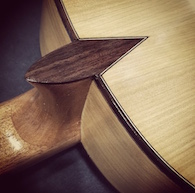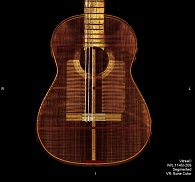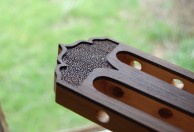Welcome to one of the most active flamenco sites on the Internet. Guests can read most posts but if you want to participate click here to register.
This site is dedicated to the memory of Paco de Lucía, Ron Mitchell, Guy Williams, Linda Elvira, Philip John Lee, Craig Eros, Ben Woods, David Serva and Tom Blackshear who went ahead of us.
We receive 12,200 visitors a month from 200 countries and 1.7 million page impressions a year. To advertise on this site please contact us.
|

|
|
RE: fine tuning a top
|
You are logged in as Guest
|
|
Users viewing this topic: none
|
|
Login  | |
|

   
Tom Blackshear
Posts: 2304
Joined: Apr. 15 2008

|
 RE: fine tuning a top (in reply to estebanana) RE: fine tuning a top (in reply to estebanana)
|
|
|
quote:
The only thing I ever read of yours that interested me was when you said there is a difference between thinning the top under the bridge and around the perimeter of the top.
Something Jose Rubio said many years ago at his Canada lecture was that thinning the top around the edges would heighten the frequency and thinning the top around the middle area would lower it.
Eugene Clark would always thin his tops toward the middle to get that extra tension, and a more bold note since his fan braces would thin out the sound to some extent, and as tension goes for this discussion.
Also, when I was in Madrid in 1965 I was in Felix Manzanero's shop on Santa Anna #12 and checked out one of his flamenco guitars that had been finished but he had gone back over it to sand some wood off in front of the bridge arms to thin out and possibly improve flex and open up the sound. His guitars at the time were pretty stiff.
And I replaced a top of his on a later model that he had sanded the top all around the bridge but left the wood under the bridge, probably to get more top flex... a quick way rather than removing the bridge.
I can add that thinning around the edges can lower the top's key tuning to where, if done carefully, thinning the middle area can bring it back to its original key if not too much is thinned out.
Thinning under the bridge can give the top some flex to enable the strings connected to the bridge to give better tension. The first sign of this, for me, came when I examined a Hernandez y Aguado 1957 flamenco guitar that was beyond repair.
His thickness out from under the bridge was at least a 1/16" taper right under the bridge, which was too much, imho. But it worked for his purposes. It was more like a gouge rather than a gentle taper.
I have found that it's quite efficient to thin no more than about .5 mm under the bridge, and feather it out, being careful to thin a little more on the treble side than on the bass, as the bass can sometimes become too flexed and lose some sustain.
Actually this lose of sustain can be the downside to most of the other "tension adjusting" techniques. So this is the reason they are done sparingly; little by little, poco a poco.
And this is the reason I developed my own sanding techniques with the strings at concert pitch; everything being done in small steps so that I don't override a positive effect on one string to where I can't bring it back.
_____________________________
Tom Blackshear Guitar maker
|
|
|
|
REPORT THIS POST AS INAPPROPRIATE |
Date Oct. 27 2012 17:15:28
 |
|

   
estebanana
Posts: 9353
Joined: Oct. 16 2009

|
 RE: fine tuning a top (in reply to Anders Eliasson) RE: fine tuning a top (in reply to Anders Eliasson)
|
|
|
quote:
I love those little tools. Especially the one with the tapplate.
Thanks Anders,
I would expect you have little tools that you have made for special jobs. I was looking forward to meeting you when I had it in mind to visit Spain again, but that may take a while now. But you're always welcome to meet me in Japan and stay a while.
Jeff,
I should have said it this way: You may be able to use these types of tools to change the brace strength or mass without changing the shape too much, if that means anything. I was also pointing out that you can make sanding fixtures for working on braces when the top is still exposed. But if you ever have to remove glue next to fan brace to fix bad cleat job, well you can work in ways that do not change the brace shape. Tools for one task often dovetail into other tasks.
Richard & Rufus,
I think you are misunderstanding the amount of twisting to mine and others underwear at the mentioning of salt rubs. I'm simply trying to keep the conversation salient, not saline.
There is only anecdotal evidence for the brace wetting /salting idea; it's never been proved or cited in any guitar making trade journals. It's a structurally dubious idea to begin with, and it is more myth than fact in a guitar world that is rife with old wives tales and harmful anecdotal cures for non existent problems. Please don't mistake my humorous straight arming with aggression when it is merely exasperated sceptical diversion. Tom is fully allowed to mention this method and I am fully allowed to refute it. I'm trying to keep the conversation focused on the reality of guitar making, not speculation about esoteric techniques that are not universally accepted. This can only be good scientific method.
The wood treatment experiments of Nagyvari are somewhat known in the violin sphere, and almost entirely dismissed by the best violin makers. The reason why is because since his basically alchemical inquiries, important old Italian violins have been studied under several kinds of state of the art microscopy techniques. The claims he makes have been soundly refuted by legitimate researchers working with samples from period violins. There have also been scientific refutations based on infrared spectroscopy of David Rubio's claims that instruments were treated with salt based coatings prior to varnishing. The current legitimate peer reviewed scientific literature on violin making has refuted every crackpot theory about varnish and wood treatment, only to deepen the mystery of why those Italian violins sound so good. If you want citations on articles and authors I can provide them.
Tom,
Thanks for your thoughts on thinning under the bridge vs. the perimeter.
_____________________________
https://www.stephenfaulkguitars.com
|
|
|
|
REPORT THIS POST AS INAPPROPRIATE |
Date Oct. 27 2012 17:41:05
 |
|

   
Tom Blackshear
Posts: 2304
Joined: Apr. 15 2008

|
 RE: fine tuning a top (in reply to estebanana) RE: fine tuning a top (in reply to estebanana)
|
|
|
quote:
There is only anecdotal evidence for the brace wetting /salting idea; it's never been proved or cited in any guitar making trade journals. It's a structurally dubious idea to begin with,
Stephen, how many techniques have you learned from your own trials and errors and then other guitar makers, do you think are written in guitar journals?
Just curious.
As I see it, most of these techniques used by the Spaniards were jealously guarded for generations, only to escape their possession by their apprentices who were careful enough to learn them. And from the lack of information about Santos Hernandez's building practice, hardly anyone knew his close mouthed approach, like he knew it.
So, I offered this salt technique to any builder who would like to try it.
I did and found that it worked. I was willing to prove my investigation of this by going forward and checking it out. And to my thinking, it was too important to hypothesize without giving it a valid check.
But I have found a proficient way to sand the braces, microscopically, to achieve the same end result.
I can see Arcangel's approach by his using water and salt, as it didn't broad-cast any alteration of the fan brace thickness, but with my technique, no one is going to be able see the area to begin with, as it is too small to be able to measure.
_____________________________
Tom Blackshear Guitar maker
|
|
|
|
REPORT THIS POST AS INAPPROPRIATE |
Date Oct. 27 2012 18:21:08
 |
|

   
TANúñez
Posts: 2559
Joined: Jul. 10 2003
From: TEXAS

|
 RE: fine tuning a top (in reply to Tom Blackshear) RE: fine tuning a top (in reply to Tom Blackshear)
|
|
|
quote:
Obviously, I'm not doing a very good job.
Tom, whether I agree or disagree with some of your methods, they are still valuable. I enjoy reading your posts as well as the other luthiers here. You can't imagine what I have learned here from you, Anders, Stephen, Shelton, Tsorba, Culpepper, the list goes on and on. Isn't that what the Luthiers section is for anyway. To swap ideas and share knowledge? No matter how experienced one may be, I don't think you ever stop learning. I think you've done a great job.
_____________________________
Tom Núñez
www.instagram.com/tanunezguitars
|
|
|
|
REPORT THIS POST AS INAPPROPRIATE |
Date Oct. 27 2012 22:18:02
 |
|

   
Tom Blackshear
Posts: 2304
Joined: Apr. 15 2008

|
 RE: fine tuning a top (in reply to estebanana) RE: fine tuning a top (in reply to estebanana)
|
|
|
quote:
I have doubts, I have breakthroughs, but some of us are more private about our connection to the tactile aspects of guitar making
I think I understand what you mean. So I'll sign off with my previously written short article on guitar situations in general.
I think wolf notes can be avoided but not always easily. Sometimes it takes me considerable hair pulling to get the G string just right to where it is smooth and attractive; something that blends with the other trebles in a vowel sound rather that just string noise, no matter how graceful.
The vowel sound, for me, comes from the middle of the string register, not necessarily on the outside strings. And this is what seems to carry quite far in a concert hall, as long as the other string sounds are compatible.
For me, the trick is to give the outside treble a higher frequency but allow the inside voice to push the envelope with an earthy compelling character that is not too heavy or dedicated in its tone, as to interfere with the musical composition.
The voice should be slight in its own character but persuasive enough to compliment the music, not over-power it. If people are pulled into the character of the guitar's sound, too much, then this will detract from the music, to some extent.
But tone is tone, and the wonderful part of music, is tone, and its expressive value to the people who hear it. And the more versatile the tone is, the wider dimension of enjoyment.
I think it is truly possible to build character into a thin top; cedar or spruce, as long as the bracing pattern will guard the structure of the top from collapsing.
And there are ways to eliminate wolf notes from thin tops by finely tuning the top. However, every top design has to be treated differently. I could not say that I would fine tune every uniquely designed instrument the same.
But in closing, I'd like to say that a guitar should be a beautiful friend and like any person, we are not perfect, but the most compelling part to any person, as well as the guitar, is, that they stand on their own with their own individual appeal. This is what makes a guitar what it is.
And this is what humanity is, not so much correct in all of our individual parts but beautiful in our entire unity. When a guitar maker considers this unique style of working out his plan, then he is on the right path.
And the fact is it will have some unevenness in its working parts. But the ideal is to bring all of these uneven parts into a place where everything works for the good of the entire guitar.
This was commented on by some Spanish builders of old, that when all of the mistakes come together, then a miracle happens.
This is what fine adjustments are supposed to produce but not all guitars are created equal; for not only inter-dimensional tone has to be right but all aspects of playability have to follow.
This is what makes guitar building extremely challenging. A guitar player is like an Island surrounded by a sea of music, and a guitar maker is like an Island with-in an Island. Or at least this is what I think we strive for, to make something that stirs the capacity of one's soul for musical expression.
_____________________________
Tom Blackshear Guitar maker
|
|
|
|
REPORT THIS POST AS INAPPROPRIATE |
Date Oct. 27 2012 22:22:39
 |
|

  
KMMI77
Posts: 1821
Joined: Jul. 26 2009
From: The land down under

|
 RE: fine tuning a top (in reply to Anders Eliasson) RE: fine tuning a top (in reply to Anders Eliasson)
|
|
|
quote:
KMMI77
There are so many persons out there looking for the holy grail. It might be the keeper car, the keeper wife, the keeper dog, the keeper guitar or even the keeper life.
Very often the problem is inside themselves and not in some exterior thing.
That's some really good advice Anders and i totally agree.
quote:
If you start fine tunin guitars every time you dont feel happy. You can be sure that many really great instruments will be ruined. This way you´ll not only ruin the guitars but also the good name of the builder.
So I will repeat... If you ever do so with any of my guitars, please remeove the label and sand away the signature on the inside of the soundboard.
Just for the record, I have never tampered with any hand made luthier guitars. Only cheap factory guitars. I think everyone here understands your point and concerns.
quote:
Fine tuning is something the builder does when building the guitar and its part of his/her signature. Please show us some respect!!!!!!!!!!!!!!
Unfortunately when you sell a guitar you sell it.
quote:
TomB´s intentions where to show builders how to make better guitars and NOT to show how to ruin other makers guitars. (TomB, correct me if I´m wrong ) Go back and read his and others posts.
The thread is going completely crazy.
I am just sharing some thoughts. If I choose to have a guitar that i have paid for modified by an experienced luthier like Tom, That is my choice. People modify other peoples artistic creations all the time. Houses, recipes, music, falsetas, gardens etc.. the list goes on.
Personally i would rather have a guitar that had been modified and sounded great as apposed to the original version if it had issues. Remember we are talking about guitars with issues and not guitars that are already working well.
_____________________________
|
|
|
|
REPORT THIS POST AS INAPPROPRIATE |
Date Oct. 29 2012 8:55:16
 |
|

   
Andy Culpepper
Posts: 3023
Joined: Mar. 30 2009
From: NY, USA

|
 RE: fine tuning a top (in reply to Anders Eliasson) RE: fine tuning a top (in reply to Anders Eliasson)
|
|
|
I know I'm weighing in late here but just to add my perspective...
I think people put a little too much weight on what you can achieve with brace adjustments. Compared to the inherent stiffness of the top plate, the braces on a classical or flamenco guitar add a relatively small percentage of stiffness, whereas on a steel string the majority of the stiffness of the top comes from the braces.
I have shaved/sanded braces down on a finished guitar, especially the ones under the bridge when I wanted to lower the resonance a little bit, but I think where you can really perfect the voicing of a guitar is through perfect thicknessing and graduation of the top plate.
So while you can have a small effect by shaving down a couple of braces, it's not going to really improve the guitar if your top is simply too thick all over or in certain areas. The top plate is key IMO, and bridge weight is the #2 factor.
It seems kind of silly to put too much emphasis on adjusting the fan braces, when you're leaving the gigantic braces like the bridge and harmonic bar alone. You're just fiddling with what's accessible on a finished guitar, but that can't compensate for subpar handling of the top and back plates and the bridge.
I'm in no way saying that any builder's method is not leading to producing great guitars, I'm just saying that you need to do a lot more than little brace adjustments to make a great guitar.
_____________________________
Andy Culpepper, luthier
http://www.andyculpepper.com
|
|
|
|
REPORT THIS POST AS INAPPROPRIATE |
Date Oct. 29 2012 13:54:59
 |
|

   
wfrancis86
Posts: 36
Joined: Jun. 30 2012

|
 RE: fine tuning a top (in reply to Anders Eliasson) RE: fine tuning a top (in reply to Anders Eliasson)
|
|
|
I think players would be far better off practicing that extra few hours than trying to digest what Tom B has been trying to convey. For the luthiers, and sorry for the lame pun, IMO this all needs to be taken with a grain of salt. If it has worked for Tom B then great for him (and thanks for the interesting reading Tom), and if other luthiers want to try it out, go for it and take a risk, its your reputation on the line not Tom's. Luthier's ought to be judged by the quality of their guitars not the techniques they use to make those guitars. If Nagyvary made great violins by peeing on them then maybe we wouldn't be making fun of him, but the proof is in the pudding so to speak. No matter how many violins he peed on there is no way to circumvent this reality. Maybe Nagyvary was unable to come to terms with reality in his search for the holy grail... in this sense his endeavors may be viewed as tragic.
I've now completed my first guitar (and admittedly I didn't make 100% of it with my own hands, so take what I have to say with the most microscopic grain of salt or just scoff at me) and I've had the opportunity to ask questions and see two great luthiers work their magic in their shops. From my limited observation so far it is striking to see how individual their approaches are. They are good people to begin with and take a humble approach to their trade and what I am spouting here are largely lessons I have learned from them. People can talk about their art but in terms of transmuting that knowledge I don't know if their words really do their technique justice. This is unfortunate and I think most luthiers on this forum would agree. We love our work and that's why we do it, and that's why some of us have the audacity to open our mouths and talk about it. We can't help it. As a novice I ask questions and so the luthiers give me their best answers but I think there is always an element of frustration on both sides. The way to address this frustration is to build many guitars with your own hands and thus gain that "muscle memory" and intuition that quells that frustration to some degree (or at least allows us to come to better terms with it).
There are no shortcuts in life and to suggest so, as I think Anders in particular would concur, is offensive to those who have dedicated their heart and souls to a craft in order to come to terms with this reality. So to come back to my original thought: players go play your instruments and if they are sub par then get better and learn to coax the sounds you want out of those instruments by practicing (not by having the gull to go and tell some respectable luthier that you heard on this forum once that a great builder applied salt to the braces and like magic the guitar went from sounding like crap to amazing), after all this is how all great flamenco guitarists throughout history have become great (and not by receiving some magical amulet from their gypsy grandfathers)... and builders keep building more guitars (I know I will) and whether you want to take the risk of investing in the salt application (or any other method you might wander across) is your call but surely if you build more guitars you will arrive at your own conclusions in time. These are my thoughts on the matter at least. Sorry for the rant.
|
|
|
|
REPORT THIS POST AS INAPPROPRIATE |
Date Oct. 29 2012 13:56:44
 |
|

   
Tom Blackshear
Posts: 2304
Joined: Apr. 15 2008

|
 RE: fine tuning a top (in reply to Andy Culpepper) RE: fine tuning a top (in reply to Andy Culpepper)
|
|
|
quote:
I have shaved/sanded braces down on a finished guitar, especially the ones under the bridge when I wanted to lower the resonance a little bit, but I think where you can really perfect the voicing of a guitar is through perfect thicknessing and graduation of the top plate.
So while you can have a small effect by shaving down a couple of braces, it's not going to really improve the guitar if your top is simply too thick all over or in certain areas. The top plate is key IMO, and bridge weight is the #2 factor.
It seems kind of silly to put too much emphasis on adjusting the fan braces, when you're leaving the gigantic braces like the bridge and harmonic bar alone. You're just fiddling with what's accessible on a finished guitar, but that can't compensate for sub-par handling of the top and back plates and the bridge.
Andy, you say a lot of good things here. But my reference is when everything else is in place, tweaking the braces can help the balance and voice, to finish out the instrument, if it needs it in the first place. And for the past 30 + years I've made very few guitars that I would say needed no additional fine-tuning.
I experimented with just about every top graduation known to man but there was always something that called to my own senses, that there must be a way for the voice to be made better than just top graduation. And it was not that my guitars suffered from a bad voice but there were more than a few times when I had to replace a top, as it just didn't work right.
So, now with my fine-tuning technique, I rarely, if ever, have to replace a top.
All guitars have to be correct in their (fan brace to top wood mass), if one or the other is off, it will adversely effect the top's function for volume and tone.
But my fine-tuning technique is to tweak the minor areas for nuance and synergistic blending of balance and tone. So, this is a learned technique that requires a certain amount of intuitive skill, and most builders can learn this if they choose to.
_____________________________
Tom Blackshear Guitar maker
|
|
|
|
REPORT THIS POST AS INAPPROPRIATE |
Date Oct. 29 2012 14:36:37
 |
|
 New Messages New Messages |
 No New Messages No New Messages |
 Hot Topic w/ New Messages Hot Topic w/ New Messages |
 Hot Topic w/o New Messages Hot Topic w/o New Messages |
 Locked w/ New Messages Locked w/ New Messages |
 Locked w/o New Messages Locked w/o New Messages |
|
 Post New Thread
Post New Thread
 Reply to Message
Reply to Message
 Post New Poll
Post New Poll
 Submit Vote
Submit Vote
 Delete My Own Post
Delete My Own Post
 Delete My Own Thread
Delete My Own Thread
 Rate Posts
Rate Posts
|
|
|
Forum Software powered by ASP Playground Advanced Edition 2.0.5
Copyright © 2000 - 2003 ASPPlayground.NET |
0.140625 secs.
|


 Printable Version
Printable Version












 New Messages
New Messages No New Messages
No New Messages Hot Topic w/ New Messages
Hot Topic w/ New Messages Hot Topic w/o New Messages
Hot Topic w/o New Messages Locked w/ New Messages
Locked w/ New Messages Locked w/o New Messages
Locked w/o New Messages Post New Thread
Post New Thread